Environmental Sustainability in Modular Building Construction Report
VerifiedAdded on 2022/09/26
|10
|2800
|27
Report
AI Summary
This report provides a detailed analysis of modular building construction systems, highlighting the challenges and opportunities within the industry. It explores the concept of utilizing waste plastic materials in the manufacturing of prefabricated components to enhance environmental sustainability, addressing concerns related to logging and material sourcing. The report outlines the benefits of this innovative approach, including reduced costs, faster construction times, and a smaller environmental footprint. It also discusses potential improvements and recommendations to further optimize modular construction techniques, emphasizing the importance of digitalization and the exploration of alternative, environmentally friendly materials and methods. The report concludes by emphasizing the positive impact of this approach on the environment and the construction industry, promoting a harmonious balance between sustainable practices and efficient building processes. It also highlights the importance of commitment from designers and contractors for successful implementation.
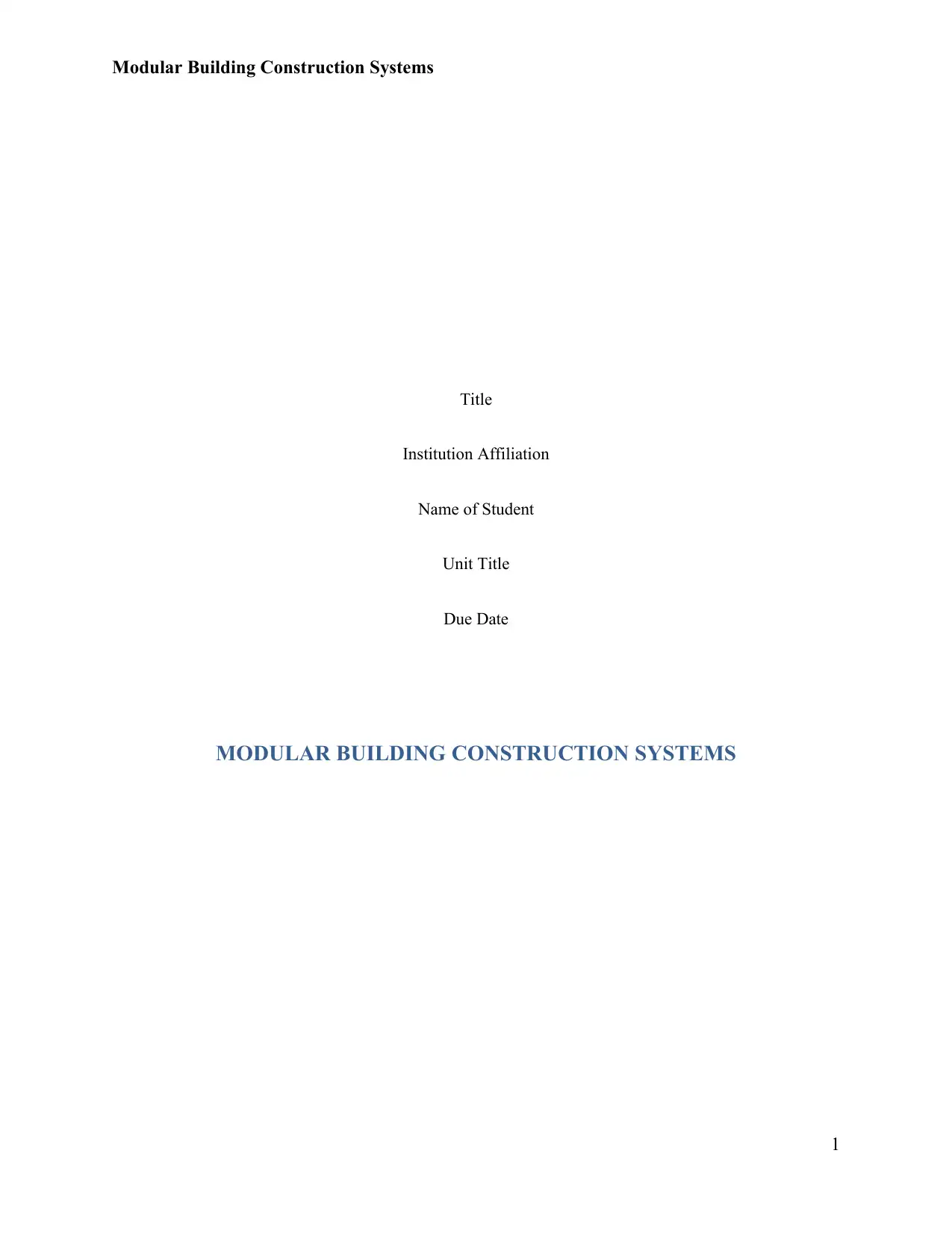
Modular Building Construction Systems
Title
Institution Affiliation
Name of Student
Unit Title
Due Date
MODULAR BUILDING CONSTRUCTION SYSTEMS
1
Title
Institution Affiliation
Name of Student
Unit Title
Due Date
MODULAR BUILDING CONSTRUCTION SYSTEMS
1
Paraphrase This Document
Need a fresh take? Get an instant paraphrase of this document with our AI Paraphraser
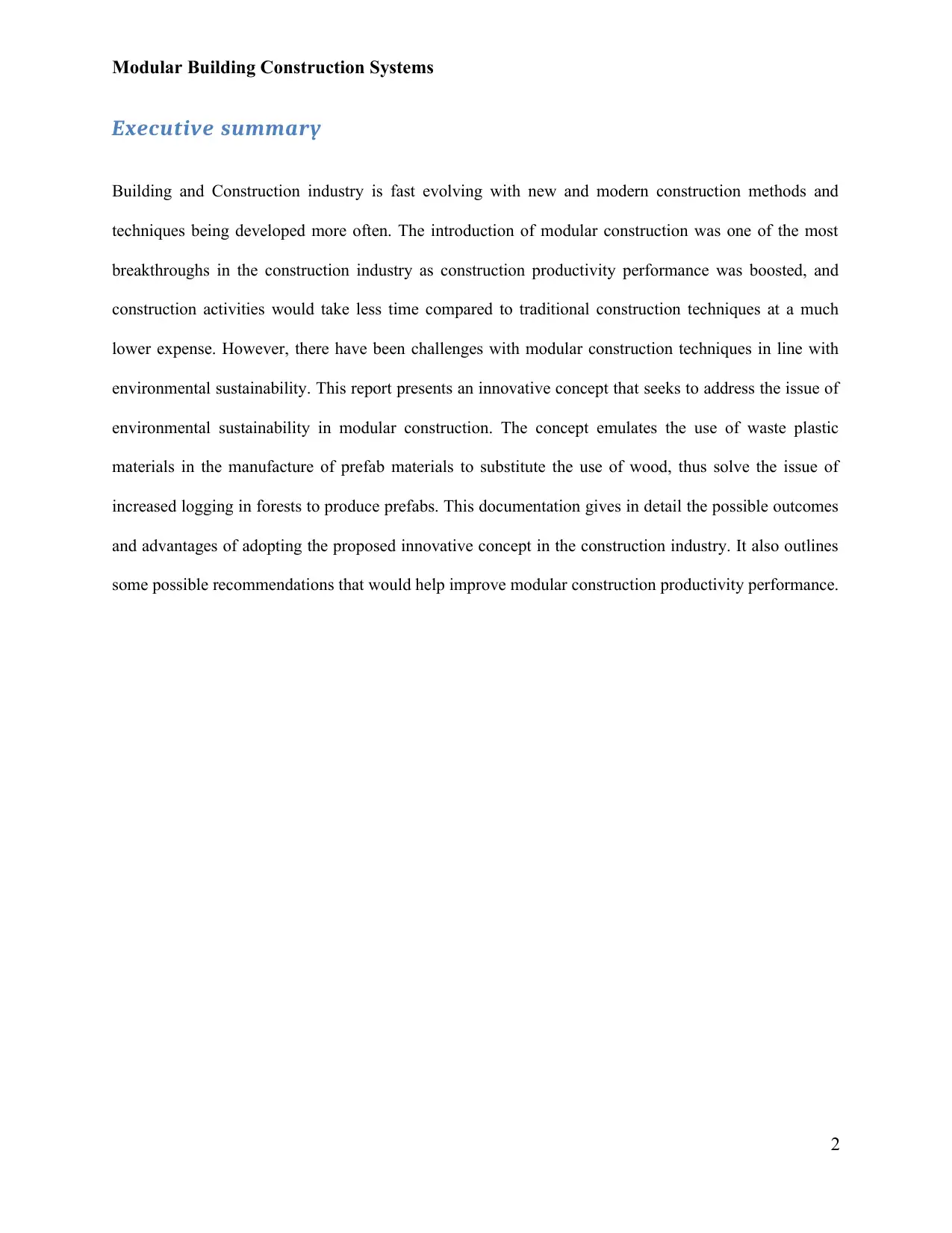
Modular Building Construction Systems
Executive summary
Building and Construction industry is fast evolving with new and modern construction methods and
techniques being developed more often. The introduction of modular construction was one of the most
breakthroughs in the construction industry as construction productivity performance was boosted, and
construction activities would take less time compared to traditional construction techniques at a much
lower expense. However, there have been challenges with modular construction techniques in line with
environmental sustainability. This report presents an innovative concept that seeks to address the issue of
environmental sustainability in modular construction. The concept emulates the use of waste plastic
materials in the manufacture of prefab materials to substitute the use of wood, thus solve the issue of
increased logging in forests to produce prefabs. This documentation gives in detail the possible outcomes
and advantages of adopting the proposed innovative concept in the construction industry. It also outlines
some possible recommendations that would help improve modular construction productivity performance.
2
Executive summary
Building and Construction industry is fast evolving with new and modern construction methods and
techniques being developed more often. The introduction of modular construction was one of the most
breakthroughs in the construction industry as construction productivity performance was boosted, and
construction activities would take less time compared to traditional construction techniques at a much
lower expense. However, there have been challenges with modular construction techniques in line with
environmental sustainability. This report presents an innovative concept that seeks to address the issue of
environmental sustainability in modular construction. The concept emulates the use of waste plastic
materials in the manufacture of prefab materials to substitute the use of wood, thus solve the issue of
increased logging in forests to produce prefabs. This documentation gives in detail the possible outcomes
and advantages of adopting the proposed innovative concept in the construction industry. It also outlines
some possible recommendations that would help improve modular construction productivity performance.
2
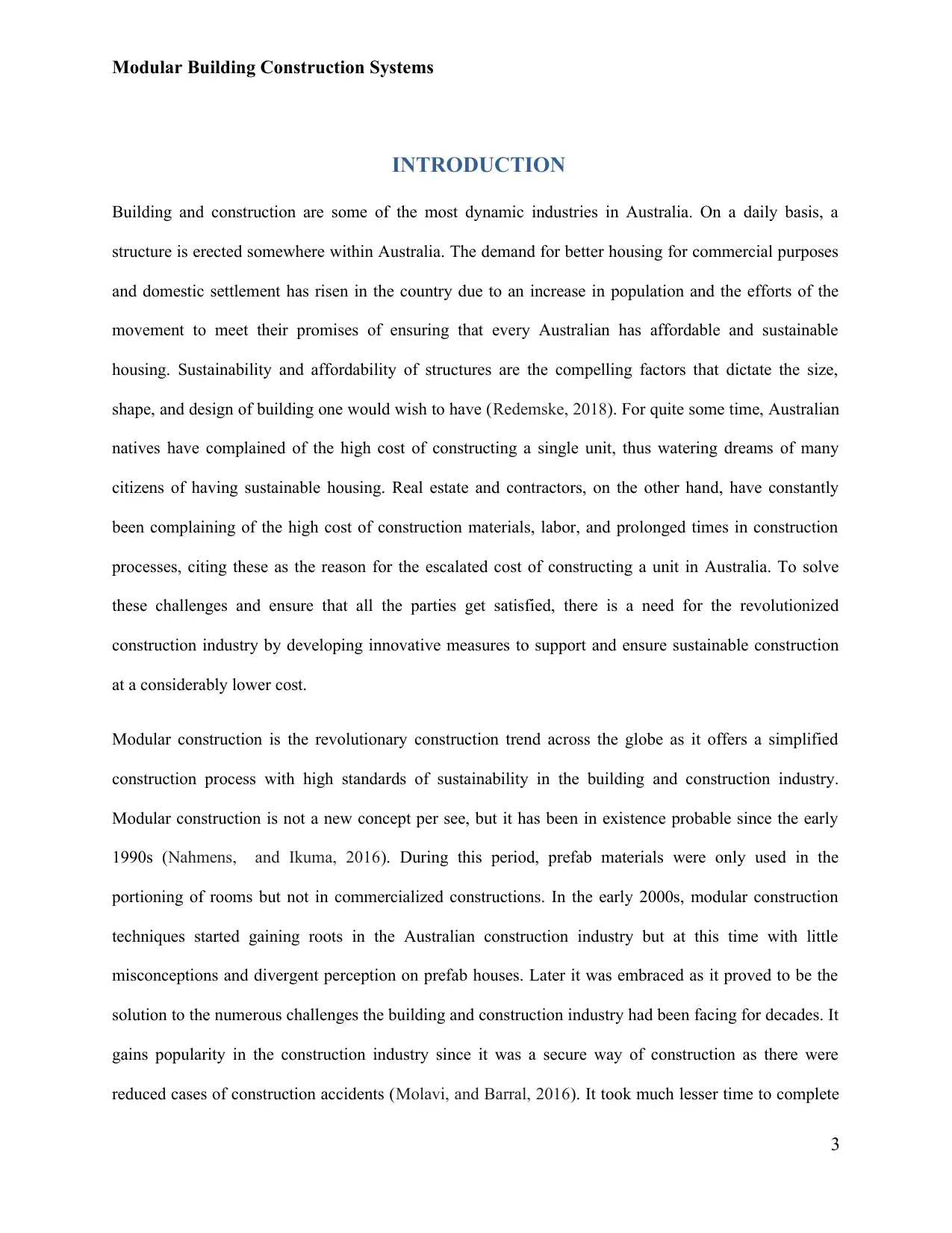
Modular Building Construction Systems
INTRODUCTION
Building and construction are some of the most dynamic industries in Australia. On a daily basis, a
structure is erected somewhere within Australia. The demand for better housing for commercial purposes
and domestic settlement has risen in the country due to an increase in population and the efforts of the
movement to meet their promises of ensuring that every Australian has affordable and sustainable
housing. Sustainability and affordability of structures are the compelling factors that dictate the size,
shape, and design of building one would wish to have (Redemske, 2018). For quite some time, Australian
natives have complained of the high cost of constructing a single unit, thus watering dreams of many
citizens of having sustainable housing. Real estate and contractors, on the other hand, have constantly
been complaining of the high cost of construction materials, labor, and prolonged times in construction
processes, citing these as the reason for the escalated cost of constructing a unit in Australia. To solve
these challenges and ensure that all the parties get satisfied, there is a need for the revolutionized
construction industry by developing innovative measures to support and ensure sustainable construction
at a considerably lower cost.
Modular construction is the revolutionary construction trend across the globe as it offers a simplified
construction process with high standards of sustainability in the building and construction industry.
Modular construction is not a new concept per see, but it has been in existence probable since the early
1990s (Nahmens, and Ikuma, 2016). During this period, prefab materials were only used in the
portioning of rooms but not in commercialized constructions. In the early 2000s, modular construction
techniques started gaining roots in the Australian construction industry but at this time with little
misconceptions and divergent perception on prefab houses. Later it was embraced as it proved to be the
solution to the numerous challenges the building and construction industry had been facing for decades. It
gains popularity in the construction industry since it was a secure way of construction as there were
reduced cases of construction accidents (Molavi, and Barral, 2016). It took much lesser time to complete
3
INTRODUCTION
Building and construction are some of the most dynamic industries in Australia. On a daily basis, a
structure is erected somewhere within Australia. The demand for better housing for commercial purposes
and domestic settlement has risen in the country due to an increase in population and the efforts of the
movement to meet their promises of ensuring that every Australian has affordable and sustainable
housing. Sustainability and affordability of structures are the compelling factors that dictate the size,
shape, and design of building one would wish to have (Redemske, 2018). For quite some time, Australian
natives have complained of the high cost of constructing a single unit, thus watering dreams of many
citizens of having sustainable housing. Real estate and contractors, on the other hand, have constantly
been complaining of the high cost of construction materials, labor, and prolonged times in construction
processes, citing these as the reason for the escalated cost of constructing a unit in Australia. To solve
these challenges and ensure that all the parties get satisfied, there is a need for the revolutionized
construction industry by developing innovative measures to support and ensure sustainable construction
at a considerably lower cost.
Modular construction is the revolutionary construction trend across the globe as it offers a simplified
construction process with high standards of sustainability in the building and construction industry.
Modular construction is not a new concept per see, but it has been in existence probable since the early
1990s (Nahmens, and Ikuma, 2016). During this period, prefab materials were only used in the
portioning of rooms but not in commercialized constructions. In the early 2000s, modular construction
techniques started gaining roots in the Australian construction industry but at this time with little
misconceptions and divergent perception on prefab houses. Later it was embraced as it proved to be the
solution to the numerous challenges the building and construction industry had been facing for decades. It
gains popularity in the construction industry since it was a secure way of construction as there were
reduced cases of construction accidents (Molavi, and Barral, 2016). It took much lesser time to complete
3
⊘ This is a preview!⊘
Do you want full access?
Subscribe today to unlock all pages.

Trusted by 1+ million students worldwide
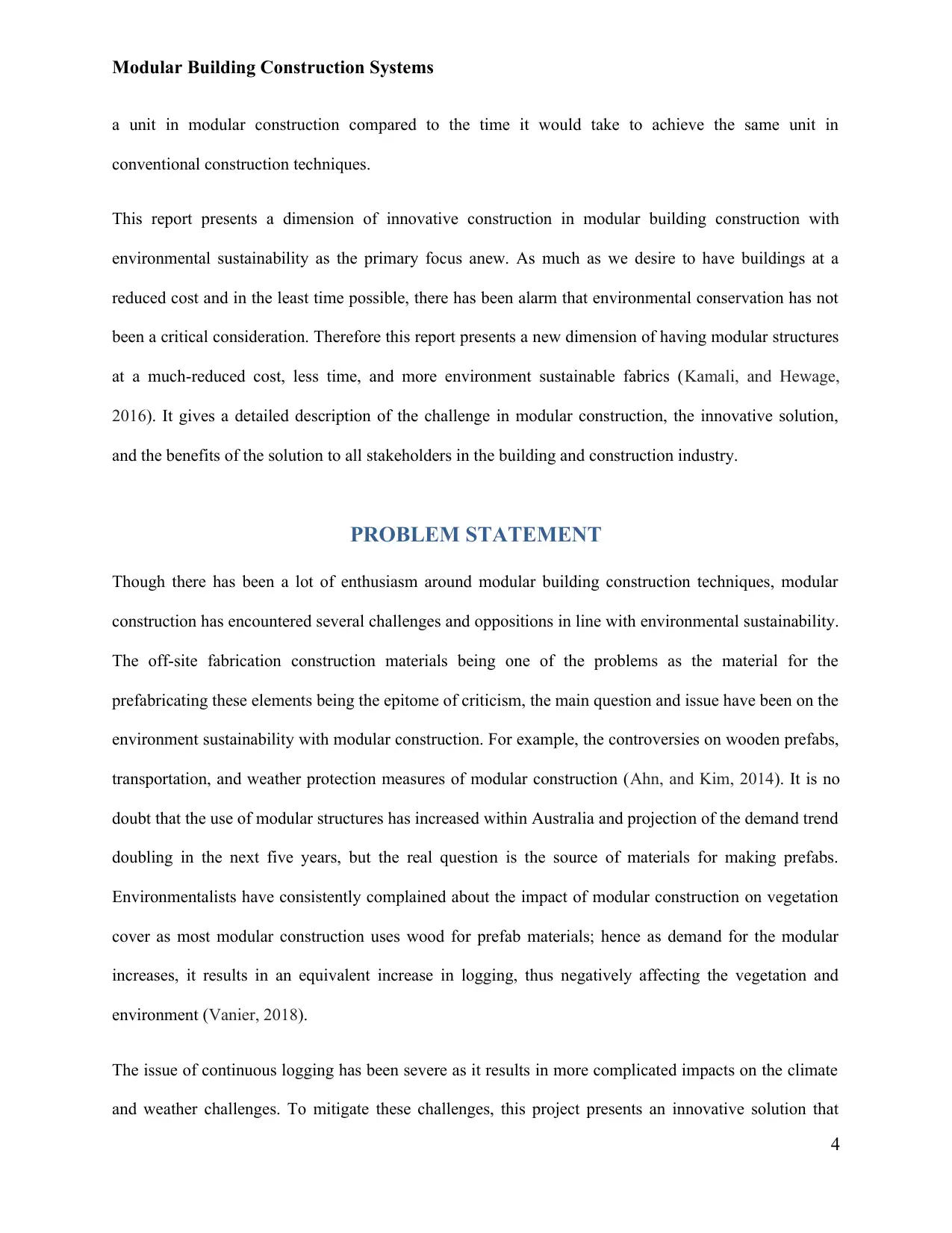
Modular Building Construction Systems
a unit in modular construction compared to the time it would take to achieve the same unit in
conventional construction techniques.
This report presents a dimension of innovative construction in modular building construction with
environmental sustainability as the primary focus anew. As much as we desire to have buildings at a
reduced cost and in the least time possible, there has been alarm that environmental conservation has not
been a critical consideration. Therefore this report presents a new dimension of having modular structures
at a much-reduced cost, less time, and more environment sustainable fabrics (Kamali, and Hewage,
2016). It gives a detailed description of the challenge in modular construction, the innovative solution,
and the benefits of the solution to all stakeholders in the building and construction industry.
PROBLEM STATEMENT
Though there has been a lot of enthusiasm around modular building construction techniques, modular
construction has encountered several challenges and oppositions in line with environmental sustainability.
The off-site fabrication construction materials being one of the problems as the material for the
prefabricating these elements being the epitome of criticism, the main question and issue have been on the
environment sustainability with modular construction. For example, the controversies on wooden prefabs,
transportation, and weather protection measures of modular construction (Ahn, and Kim, 2014). It is no
doubt that the use of modular structures has increased within Australia and projection of the demand trend
doubling in the next five years, but the real question is the source of materials for making prefabs.
Environmentalists have consistently complained about the impact of modular construction on vegetation
cover as most modular construction uses wood for prefab materials; hence as demand for the modular
increases, it results in an equivalent increase in logging, thus negatively affecting the vegetation and
environment (Vanier, 2018).
The issue of continuous logging has been severe as it results in more complicated impacts on the climate
and weather challenges. To mitigate these challenges, this project presents an innovative solution that
4
a unit in modular construction compared to the time it would take to achieve the same unit in
conventional construction techniques.
This report presents a dimension of innovative construction in modular building construction with
environmental sustainability as the primary focus anew. As much as we desire to have buildings at a
reduced cost and in the least time possible, there has been alarm that environmental conservation has not
been a critical consideration. Therefore this report presents a new dimension of having modular structures
at a much-reduced cost, less time, and more environment sustainable fabrics (Kamali, and Hewage,
2016). It gives a detailed description of the challenge in modular construction, the innovative solution,
and the benefits of the solution to all stakeholders in the building and construction industry.
PROBLEM STATEMENT
Though there has been a lot of enthusiasm around modular building construction techniques, modular
construction has encountered several challenges and oppositions in line with environmental sustainability.
The off-site fabrication construction materials being one of the problems as the material for the
prefabricating these elements being the epitome of criticism, the main question and issue have been on the
environment sustainability with modular construction. For example, the controversies on wooden prefabs,
transportation, and weather protection measures of modular construction (Ahn, and Kim, 2014). It is no
doubt that the use of modular structures has increased within Australia and projection of the demand trend
doubling in the next five years, but the real question is the source of materials for making prefabs.
Environmentalists have consistently complained about the impact of modular construction on vegetation
cover as most modular construction uses wood for prefab materials; hence as demand for the modular
increases, it results in an equivalent increase in logging, thus negatively affecting the vegetation and
environment (Vanier, 2018).
The issue of continuous logging has been severe as it results in more complicated impacts on the climate
and weather challenges. To mitigate these challenges, this project presents an innovative solution that
4
Paraphrase This Document
Need a fresh take? Get an instant paraphrase of this document with our AI Paraphraser
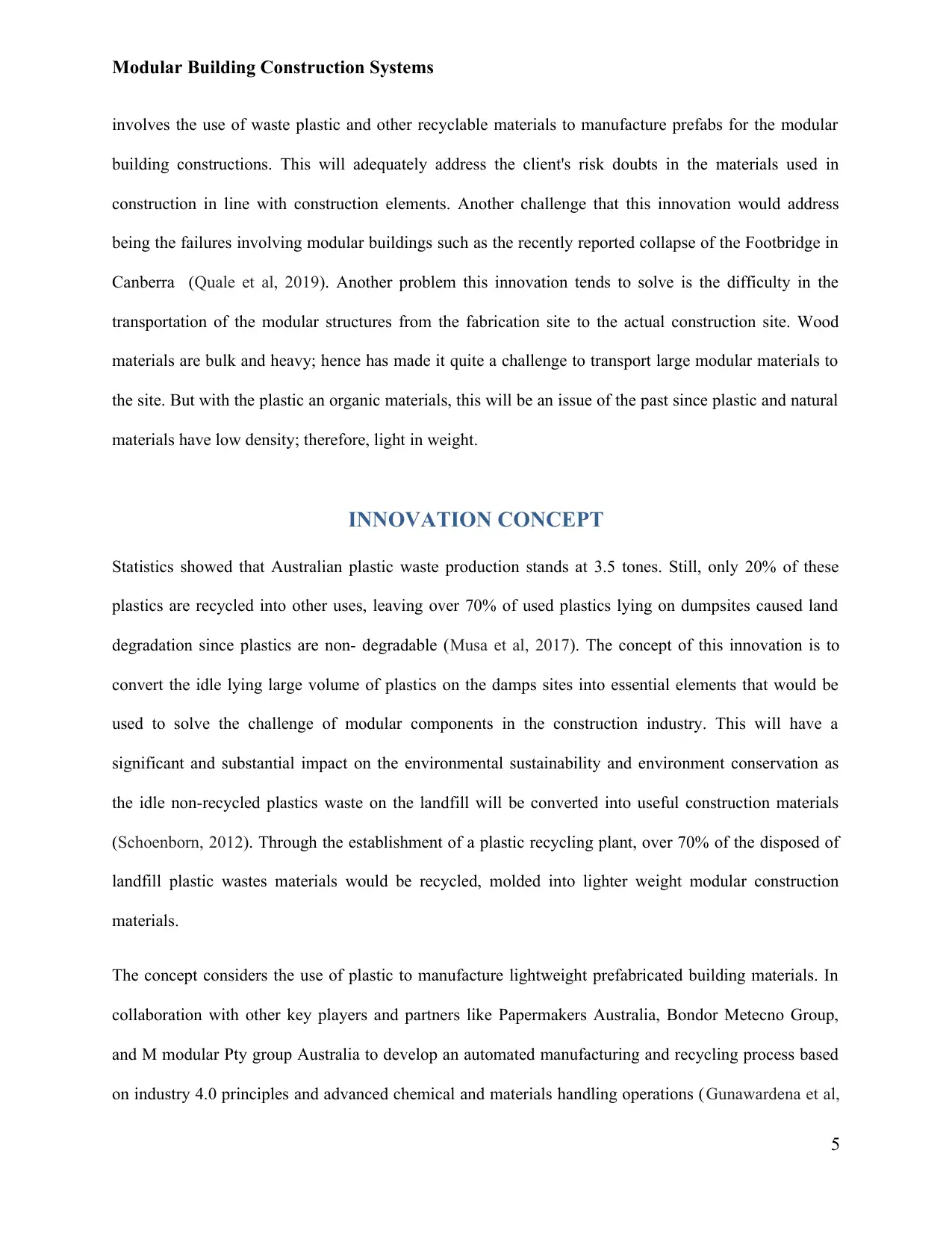
Modular Building Construction Systems
involves the use of waste plastic and other recyclable materials to manufacture prefabs for the modular
building constructions. This will adequately address the client's risk doubts in the materials used in
construction in line with construction elements. Another challenge that this innovation would address
being the failures involving modular buildings such as the recently reported collapse of the Footbridge in
Canberra (Quale et al, 2019). Another problem this innovation tends to solve is the difficulty in the
transportation of the modular structures from the fabrication site to the actual construction site. Wood
materials are bulk and heavy; hence has made it quite a challenge to transport large modular materials to
the site. But with the plastic an organic materials, this will be an issue of the past since plastic and natural
materials have low density; therefore, light in weight.
INNOVATION CONCEPT
Statistics showed that Australian plastic waste production stands at 3.5 tones. Still, only 20% of these
plastics are recycled into other uses, leaving over 70% of used plastics lying on dumpsites caused land
degradation since plastics are non- degradable (Musa et al, 2017). The concept of this innovation is to
convert the idle lying large volume of plastics on the damps sites into essential elements that would be
used to solve the challenge of modular components in the construction industry. This will have a
significant and substantial impact on the environmental sustainability and environment conservation as
the idle non-recycled plastics waste on the landfill will be converted into useful construction materials
(Schoenborn, 2012). Through the establishment of a plastic recycling plant, over 70% of the disposed of
landfill plastic wastes materials would be recycled, molded into lighter weight modular construction
materials.
The concept considers the use of plastic to manufacture lightweight prefabricated building materials. In
collaboration with other key players and partners like Papermakers Australia, Bondor Metecno Group,
and M modular Pty group Australia to develop an automated manufacturing and recycling process based
on industry 4.0 principles and advanced chemical and materials handling operations ( Gunawardena et al,
5
involves the use of waste plastic and other recyclable materials to manufacture prefabs for the modular
building constructions. This will adequately address the client's risk doubts in the materials used in
construction in line with construction elements. Another challenge that this innovation would address
being the failures involving modular buildings such as the recently reported collapse of the Footbridge in
Canberra (Quale et al, 2019). Another problem this innovation tends to solve is the difficulty in the
transportation of the modular structures from the fabrication site to the actual construction site. Wood
materials are bulk and heavy; hence has made it quite a challenge to transport large modular materials to
the site. But with the plastic an organic materials, this will be an issue of the past since plastic and natural
materials have low density; therefore, light in weight.
INNOVATION CONCEPT
Statistics showed that Australian plastic waste production stands at 3.5 tones. Still, only 20% of these
plastics are recycled into other uses, leaving over 70% of used plastics lying on dumpsites caused land
degradation since plastics are non- degradable (Musa et al, 2017). The concept of this innovation is to
convert the idle lying large volume of plastics on the damps sites into essential elements that would be
used to solve the challenge of modular components in the construction industry. This will have a
significant and substantial impact on the environmental sustainability and environment conservation as
the idle non-recycled plastics waste on the landfill will be converted into useful construction materials
(Schoenborn, 2012). Through the establishment of a plastic recycling plant, over 70% of the disposed of
landfill plastic wastes materials would be recycled, molded into lighter weight modular construction
materials.
The concept considers the use of plastic to manufacture lightweight prefabricated building materials. In
collaboration with other key players and partners like Papermakers Australia, Bondor Metecno Group,
and M modular Pty group Australia to develop an automated manufacturing and recycling process based
on industry 4.0 principles and advanced chemical and materials handling operations ( Gunawardena et al,
5
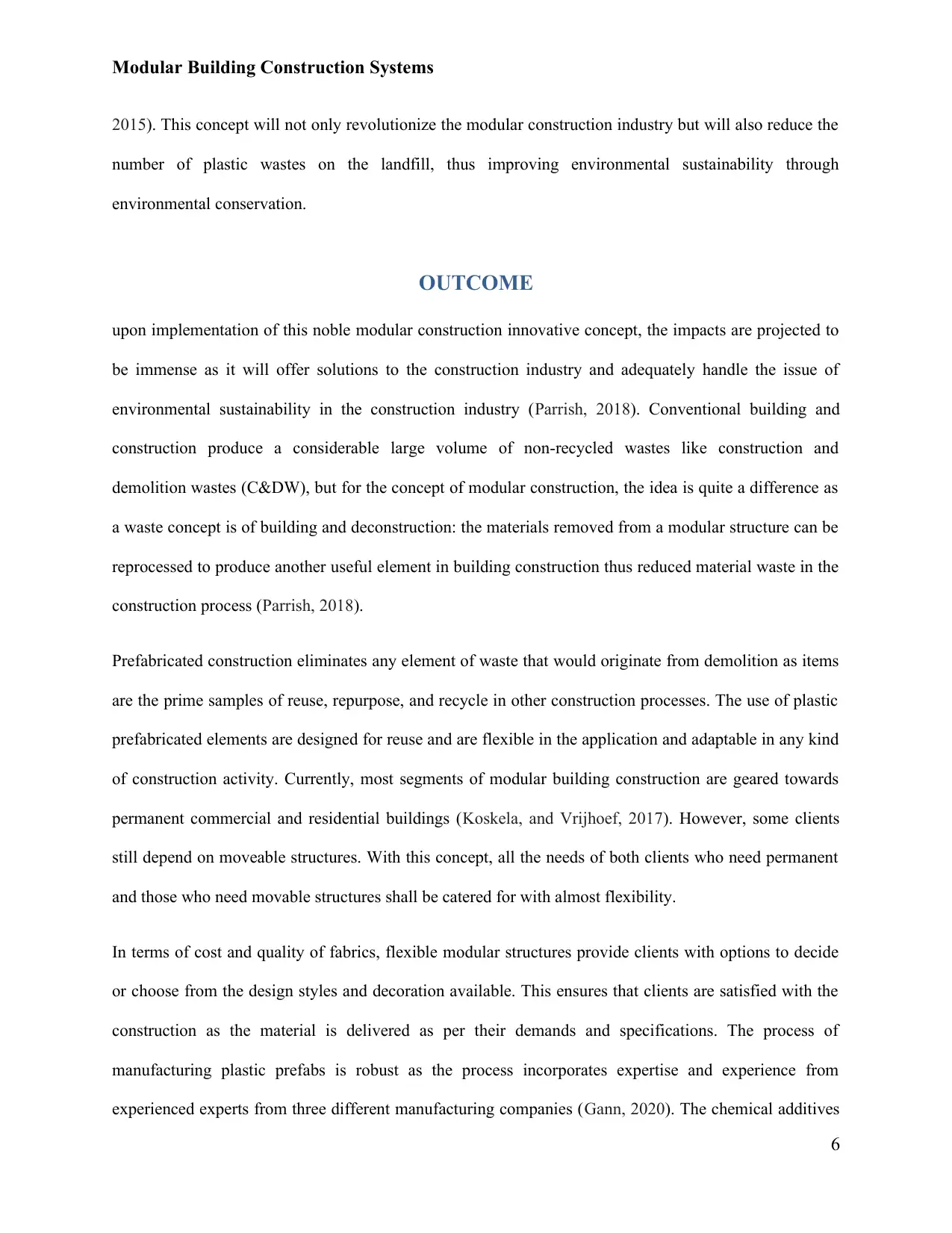
Modular Building Construction Systems
2015). This concept will not only revolutionize the modular construction industry but will also reduce the
number of plastic wastes on the landfill, thus improving environmental sustainability through
environmental conservation.
OUTCOME
upon implementation of this noble modular construction innovative concept, the impacts are projected to
be immense as it will offer solutions to the construction industry and adequately handle the issue of
environmental sustainability in the construction industry (Parrish, 2018). Conventional building and
construction produce a considerable large volume of non-recycled wastes like construction and
demolition wastes (C&DW), but for the concept of modular construction, the idea is quite a difference as
a waste concept is of building and deconstruction: the materials removed from a modular structure can be
reprocessed to produce another useful element in building construction thus reduced material waste in the
construction process (Parrish, 2018).
Prefabricated construction eliminates any element of waste that would originate from demolition as items
are the prime samples of reuse, repurpose, and recycle in other construction processes. The use of plastic
prefabricated elements are designed for reuse and are flexible in the application and adaptable in any kind
of construction activity. Currently, most segments of modular building construction are geared towards
permanent commercial and residential buildings (Koskela, and Vrijhoef, 2017). However, some clients
still depend on moveable structures. With this concept, all the needs of both clients who need permanent
and those who need movable structures shall be catered for with almost flexibility.
In terms of cost and quality of fabrics, flexible modular structures provide clients with options to decide
or choose from the design styles and decoration available. This ensures that clients are satisfied with the
construction as the material is delivered as per their demands and specifications. The process of
manufacturing plastic prefabs is robust as the process incorporates expertise and experience from
experienced experts from three different manufacturing companies (Gann, 2020). The chemical additives
6
2015). This concept will not only revolutionize the modular construction industry but will also reduce the
number of plastic wastes on the landfill, thus improving environmental sustainability through
environmental conservation.
OUTCOME
upon implementation of this noble modular construction innovative concept, the impacts are projected to
be immense as it will offer solutions to the construction industry and adequately handle the issue of
environmental sustainability in the construction industry (Parrish, 2018). Conventional building and
construction produce a considerable large volume of non-recycled wastes like construction and
demolition wastes (C&DW), but for the concept of modular construction, the idea is quite a difference as
a waste concept is of building and deconstruction: the materials removed from a modular structure can be
reprocessed to produce another useful element in building construction thus reduced material waste in the
construction process (Parrish, 2018).
Prefabricated construction eliminates any element of waste that would originate from demolition as items
are the prime samples of reuse, repurpose, and recycle in other construction processes. The use of plastic
prefabricated elements are designed for reuse and are flexible in the application and adaptable in any kind
of construction activity. Currently, most segments of modular building construction are geared towards
permanent commercial and residential buildings (Koskela, and Vrijhoef, 2017). However, some clients
still depend on moveable structures. With this concept, all the needs of both clients who need permanent
and those who need movable structures shall be catered for with almost flexibility.
In terms of cost and quality of fabrics, flexible modular structures provide clients with options to decide
or choose from the design styles and decoration available. This ensures that clients are satisfied with the
construction as the material is delivered as per their demands and specifications. The process of
manufacturing plastic prefabs is robust as the process incorporates expertise and experience from
experienced experts from three different manufacturing companies (Gann, 2020). The chemical additives
6
⊘ This is a preview!⊘
Do you want full access?
Subscribe today to unlock all pages.

Trusted by 1+ million students worldwide
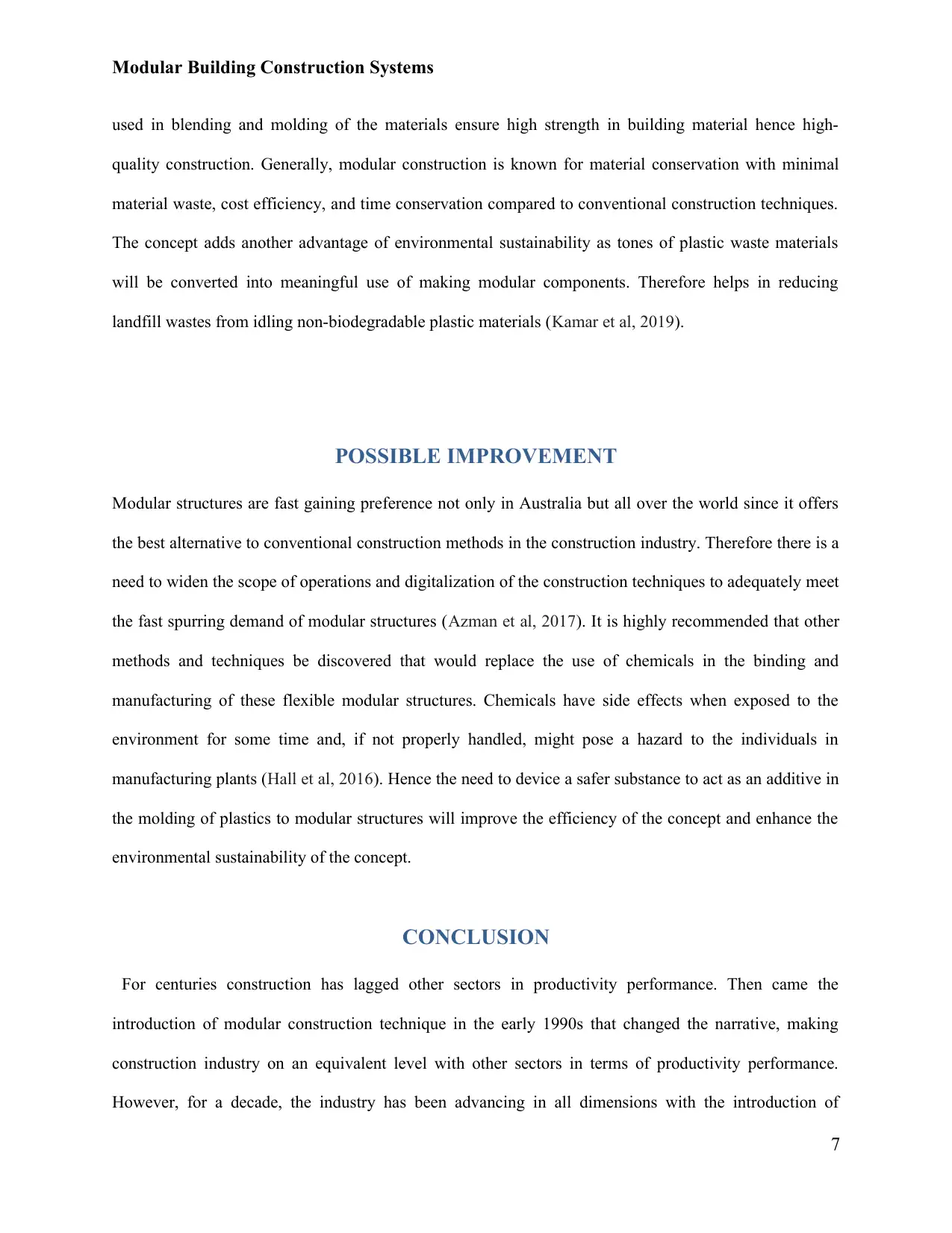
Modular Building Construction Systems
used in blending and molding of the materials ensure high strength in building material hence high-
quality construction. Generally, modular construction is known for material conservation with minimal
material waste, cost efficiency, and time conservation compared to conventional construction techniques.
The concept adds another advantage of environmental sustainability as tones of plastic waste materials
will be converted into meaningful use of making modular components. Therefore helps in reducing
landfill wastes from idling non-biodegradable plastic materials (Kamar et al, 2019).
POSSIBLE IMPROVEMENT
Modular structures are fast gaining preference not only in Australia but all over the world since it offers
the best alternative to conventional construction methods in the construction industry. Therefore there is a
need to widen the scope of operations and digitalization of the construction techniques to adequately meet
the fast spurring demand of modular structures (Azman et al, 2017). It is highly recommended that other
methods and techniques be discovered that would replace the use of chemicals in the binding and
manufacturing of these flexible modular structures. Chemicals have side effects when exposed to the
environment for some time and, if not properly handled, might pose a hazard to the individuals in
manufacturing plants (Hall et al, 2016). Hence the need to device a safer substance to act as an additive in
the molding of plastics to modular structures will improve the efficiency of the concept and enhance the
environmental sustainability of the concept.
CONCLUSION
For centuries construction has lagged other sectors in productivity performance. Then came the
introduction of modular construction technique in the early 1990s that changed the narrative, making
construction industry on an equivalent level with other sectors in terms of productivity performance.
However, for a decade, the industry has been advancing in all dimensions with the introduction of
7
used in blending and molding of the materials ensure high strength in building material hence high-
quality construction. Generally, modular construction is known for material conservation with minimal
material waste, cost efficiency, and time conservation compared to conventional construction techniques.
The concept adds another advantage of environmental sustainability as tones of plastic waste materials
will be converted into meaningful use of making modular components. Therefore helps in reducing
landfill wastes from idling non-biodegradable plastic materials (Kamar et al, 2019).
POSSIBLE IMPROVEMENT
Modular structures are fast gaining preference not only in Australia but all over the world since it offers
the best alternative to conventional construction methods in the construction industry. Therefore there is a
need to widen the scope of operations and digitalization of the construction techniques to adequately meet
the fast spurring demand of modular structures (Azman et al, 2017). It is highly recommended that other
methods and techniques be discovered that would replace the use of chemicals in the binding and
manufacturing of these flexible modular structures. Chemicals have side effects when exposed to the
environment for some time and, if not properly handled, might pose a hazard to the individuals in
manufacturing plants (Hall et al, 2016). Hence the need to device a safer substance to act as an additive in
the molding of plastics to modular structures will improve the efficiency of the concept and enhance the
environmental sustainability of the concept.
CONCLUSION
For centuries construction has lagged other sectors in productivity performance. Then came the
introduction of modular construction technique in the early 1990s that changed the narrative, making
construction industry on an equivalent level with other sectors in terms of productivity performance.
However, for a decade, the industry has been advancing in all dimensions with the introduction of
7
Paraphrase This Document
Need a fresh take? Get an instant paraphrase of this document with our AI Paraphraser
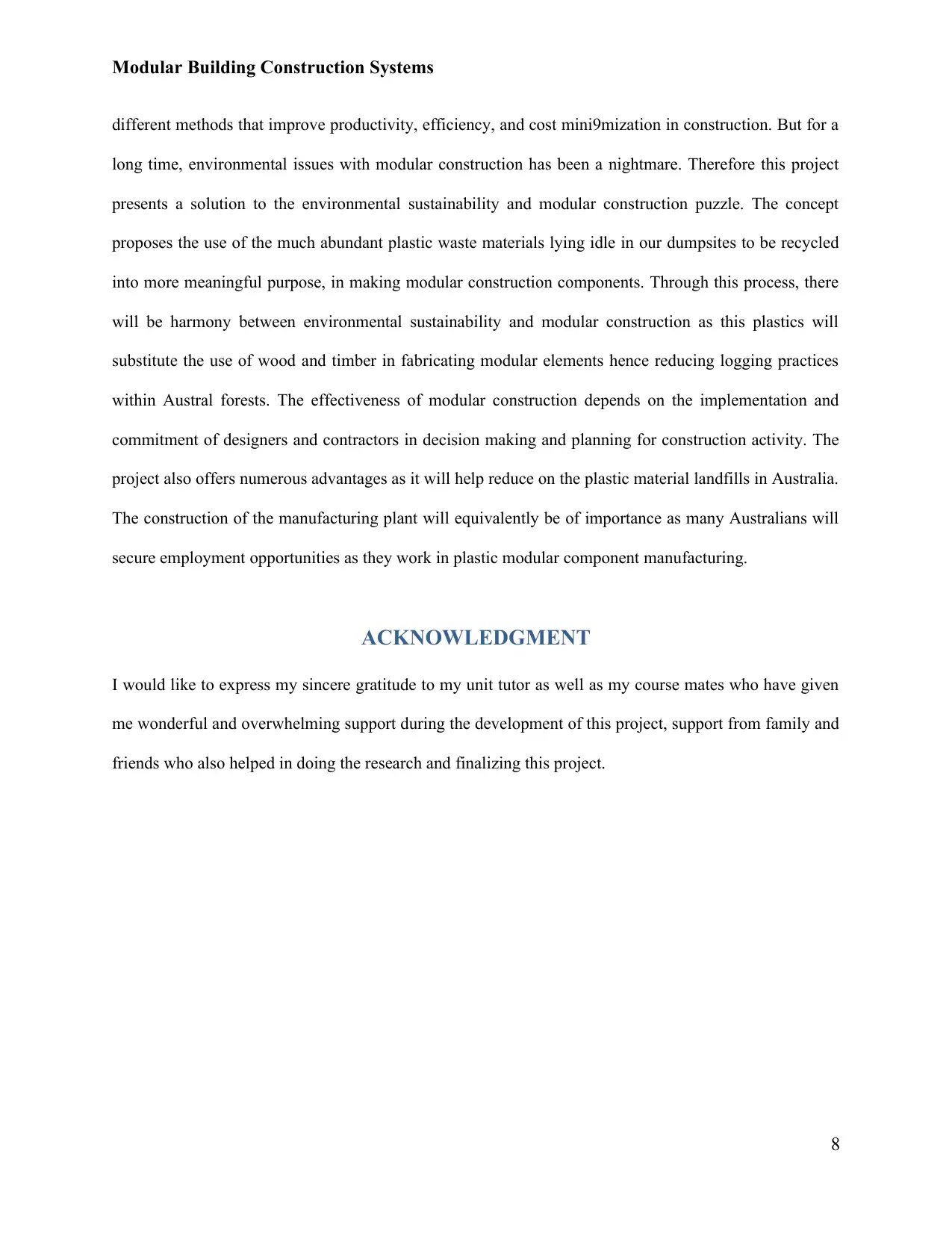
Modular Building Construction Systems
different methods that improve productivity, efficiency, and cost mini9mization in construction. But for a
long time, environmental issues with modular construction has been a nightmare. Therefore this project
presents a solution to the environmental sustainability and modular construction puzzle. The concept
proposes the use of the much abundant plastic waste materials lying idle in our dumpsites to be recycled
into more meaningful purpose, in making modular construction components. Through this process, there
will be harmony between environmental sustainability and modular construction as this plastics will
substitute the use of wood and timber in fabricating modular elements hence reducing logging practices
within Austral forests. The effectiveness of modular construction depends on the implementation and
commitment of designers and contractors in decision making and planning for construction activity. The
project also offers numerous advantages as it will help reduce on the plastic material landfills in Australia.
The construction of the manufacturing plant will equivalently be of importance as many Australians will
secure employment opportunities as they work in plastic modular component manufacturing.
ACKNOWLEDGMENT
I would like to express my sincere gratitude to my unit tutor as well as my course mates who have given
me wonderful and overwhelming support during the development of this project, support from family and
friends who also helped in doing the research and finalizing this project.
8
different methods that improve productivity, efficiency, and cost mini9mization in construction. But for a
long time, environmental issues with modular construction has been a nightmare. Therefore this project
presents a solution to the environmental sustainability and modular construction puzzle. The concept
proposes the use of the much abundant plastic waste materials lying idle in our dumpsites to be recycled
into more meaningful purpose, in making modular construction components. Through this process, there
will be harmony between environmental sustainability and modular construction as this plastics will
substitute the use of wood and timber in fabricating modular elements hence reducing logging practices
within Austral forests. The effectiveness of modular construction depends on the implementation and
commitment of designers and contractors in decision making and planning for construction activity. The
project also offers numerous advantages as it will help reduce on the plastic material landfills in Australia.
The construction of the manufacturing plant will equivalently be of importance as many Australians will
secure employment opportunities as they work in plastic modular component manufacturing.
ACKNOWLEDGMENT
I would like to express my sincere gratitude to my unit tutor as well as my course mates who have given
me wonderful and overwhelming support during the development of this project, support from family and
friends who also helped in doing the research and finalizing this project.
8
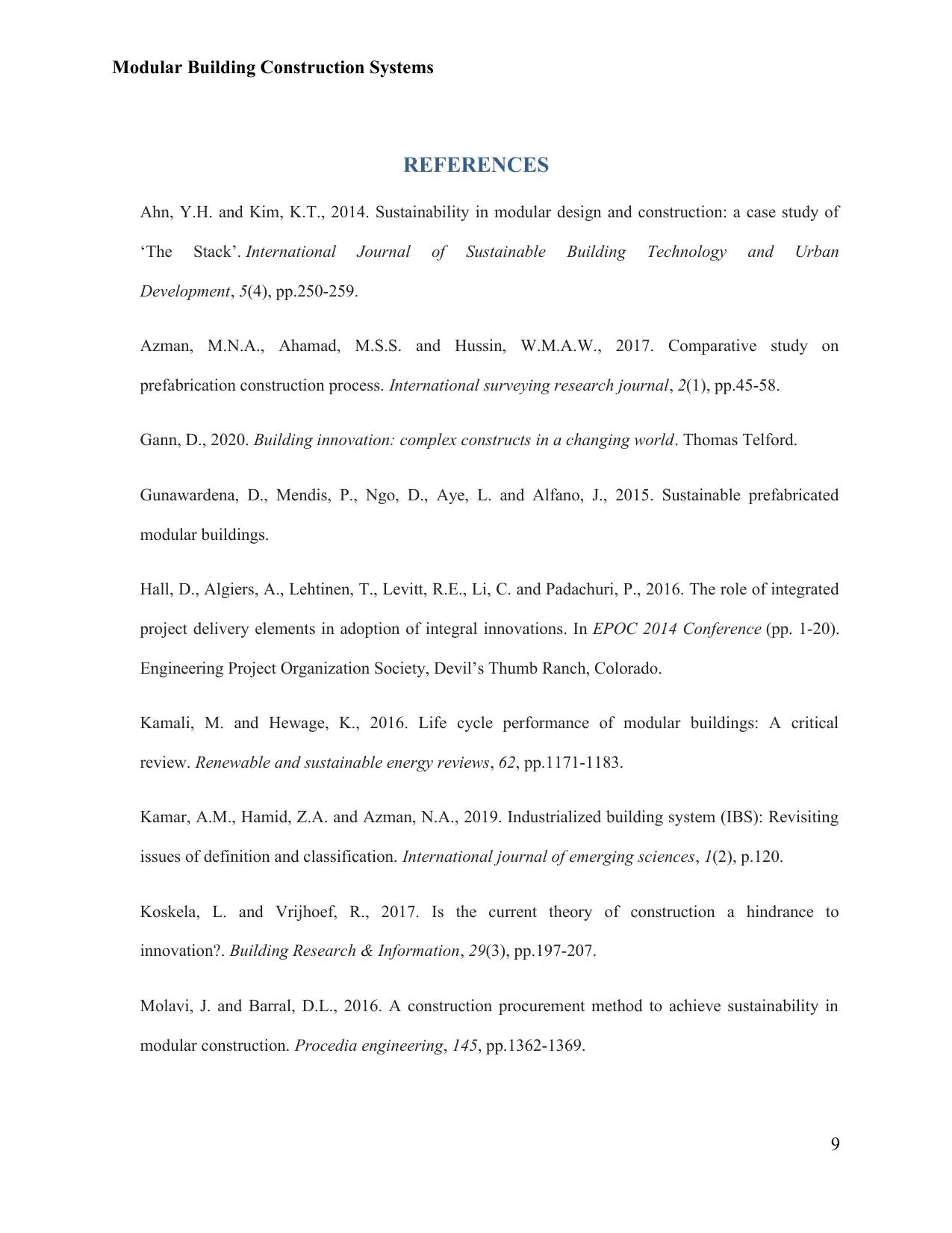
Modular Building Construction Systems
REFERENCES
Ahn, Y.H. and Kim, K.T., 2014. Sustainability in modular design and construction: a case study of
‘The Stack’. International Journal of Sustainable Building Technology and Urban
Development, 5(4), pp.250-259.
Azman, M.N.A., Ahamad, M.S.S. and Hussin, W.M.A.W., 2017. Comparative study on
prefabrication construction process. International surveying research journal, 2(1), pp.45-58.
Gann, D., 2020. Building innovation: complex constructs in a changing world. Thomas Telford.
Gunawardena, D., Mendis, P., Ngo, D., Aye, L. and Alfano, J., 2015. Sustainable prefabricated
modular buildings.
Hall, D., Algiers, A., Lehtinen, T., Levitt, R.E., Li, C. and Padachuri, P., 2016. The role of integrated
project delivery elements in adoption of integral innovations. In EPOC 2014 Conference (pp. 1-20).
Engineering Project Organization Society, Devil’s Thumb Ranch, Colorado.
Kamali, M. and Hewage, K., 2016. Life cycle performance of modular buildings: A critical
review. Renewable and sustainable energy reviews, 62, pp.1171-1183.
Kamar, A.M., Hamid, Z.A. and Azman, N.A., 2019. Industrialized building system (IBS): Revisiting
issues of definition and classification. International journal of emerging sciences, 1(2), p.120.
Koskela, L. and Vrijhoef, R., 2017. Is the current theory of construction a hindrance to
innovation?. Building Research & Information, 29(3), pp.197-207.
Molavi, J. and Barral, D.L., 2016. A construction procurement method to achieve sustainability in
modular construction. Procedia engineering, 145, pp.1362-1369.
9
REFERENCES
Ahn, Y.H. and Kim, K.T., 2014. Sustainability in modular design and construction: a case study of
‘The Stack’. International Journal of Sustainable Building Technology and Urban
Development, 5(4), pp.250-259.
Azman, M.N.A., Ahamad, M.S.S. and Hussin, W.M.A.W., 2017. Comparative study on
prefabrication construction process. International surveying research journal, 2(1), pp.45-58.
Gann, D., 2020. Building innovation: complex constructs in a changing world. Thomas Telford.
Gunawardena, D., Mendis, P., Ngo, D., Aye, L. and Alfano, J., 2015. Sustainable prefabricated
modular buildings.
Hall, D., Algiers, A., Lehtinen, T., Levitt, R.E., Li, C. and Padachuri, P., 2016. The role of integrated
project delivery elements in adoption of integral innovations. In EPOC 2014 Conference (pp. 1-20).
Engineering Project Organization Society, Devil’s Thumb Ranch, Colorado.
Kamali, M. and Hewage, K., 2016. Life cycle performance of modular buildings: A critical
review. Renewable and sustainable energy reviews, 62, pp.1171-1183.
Kamar, A.M., Hamid, Z.A. and Azman, N.A., 2019. Industrialized building system (IBS): Revisiting
issues of definition and classification. International journal of emerging sciences, 1(2), p.120.
Koskela, L. and Vrijhoef, R., 2017. Is the current theory of construction a hindrance to
innovation?. Building Research & Information, 29(3), pp.197-207.
Molavi, J. and Barral, D.L., 2016. A construction procurement method to achieve sustainability in
modular construction. Procedia engineering, 145, pp.1362-1369.
9
⊘ This is a preview!⊘
Do you want full access?
Subscribe today to unlock all pages.

Trusted by 1+ million students worldwide
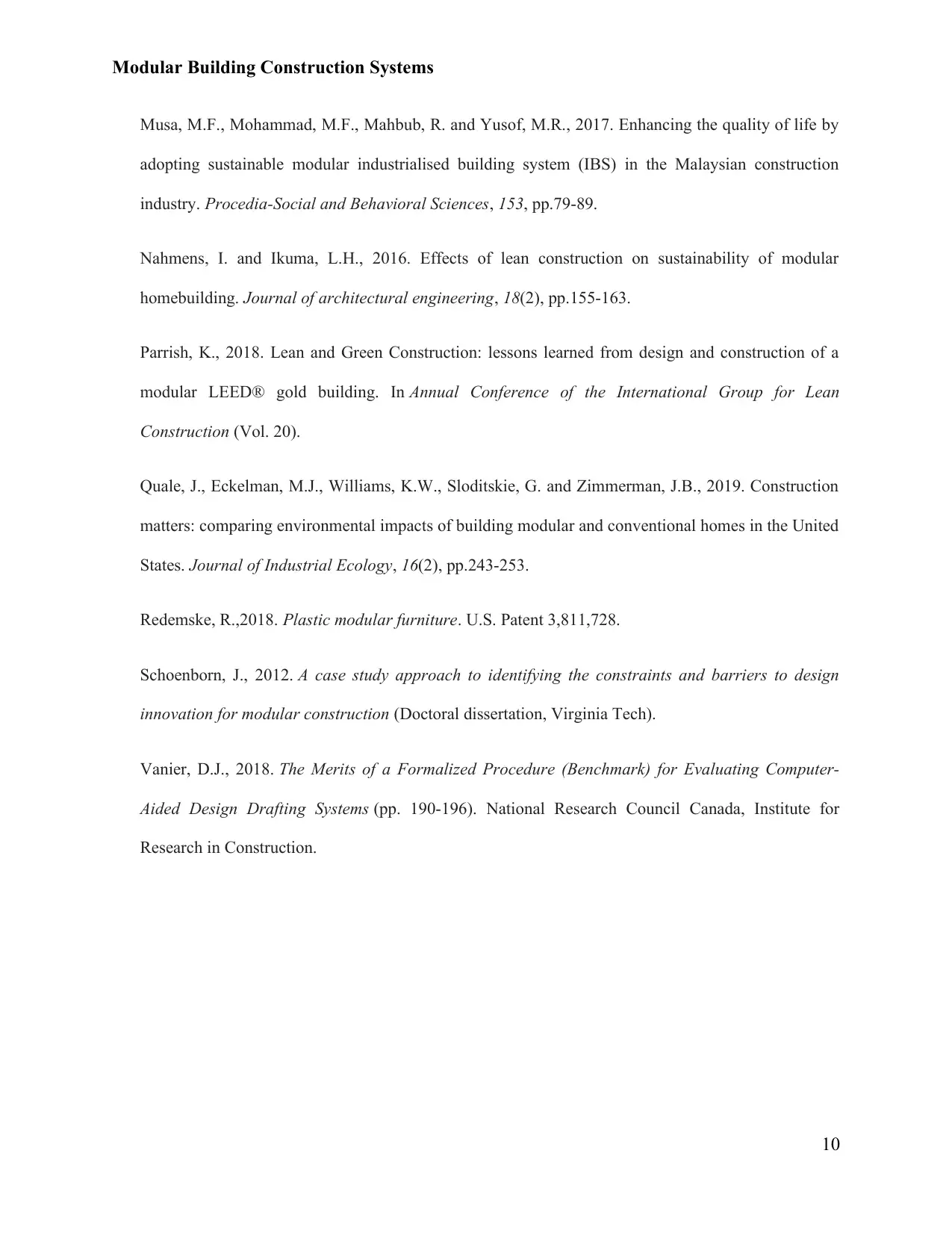
Modular Building Construction Systems
Musa, M.F., Mohammad, M.F., Mahbub, R. and Yusof, M.R., 2017. Enhancing the quality of life by
adopting sustainable modular industrialised building system (IBS) in the Malaysian construction
industry. Procedia-Social and Behavioral Sciences, 153, pp.79-89.
Nahmens, I. and Ikuma, L.H., 2016. Effects of lean construction on sustainability of modular
homebuilding. Journal of architectural engineering, 18(2), pp.155-163.
Parrish, K., 2018. Lean and Green Construction: lessons learned from design and construction of a
modular LEED® gold building. In Annual Conference of the International Group for Lean
Construction (Vol. 20).
Quale, J., Eckelman, M.J., Williams, K.W., Sloditskie, G. and Zimmerman, J.B., 2019. Construction
matters: comparing environmental impacts of building modular and conventional homes in the United
States. Journal of Industrial Ecology, 16(2), pp.243-253.
Redemske, R.,2018. Plastic modular furniture. U.S. Patent 3,811,728.
Schoenborn, J., 2012. A case study approach to identifying the constraints and barriers to design
innovation for modular construction (Doctoral dissertation, Virginia Tech).
Vanier, D.J., 2018. The Merits of a Formalized Procedure (Benchmark) for Evaluating Computer-
Aided Design Drafting Systems (pp. 190-196). National Research Council Canada, Institute for
Research in Construction.
10
Musa, M.F., Mohammad, M.F., Mahbub, R. and Yusof, M.R., 2017. Enhancing the quality of life by
adopting sustainable modular industrialised building system (IBS) in the Malaysian construction
industry. Procedia-Social and Behavioral Sciences, 153, pp.79-89.
Nahmens, I. and Ikuma, L.H., 2016. Effects of lean construction on sustainability of modular
homebuilding. Journal of architectural engineering, 18(2), pp.155-163.
Parrish, K., 2018. Lean and Green Construction: lessons learned from design and construction of a
modular LEED® gold building. In Annual Conference of the International Group for Lean
Construction (Vol. 20).
Quale, J., Eckelman, M.J., Williams, K.W., Sloditskie, G. and Zimmerman, J.B., 2019. Construction
matters: comparing environmental impacts of building modular and conventional homes in the United
States. Journal of Industrial Ecology, 16(2), pp.243-253.
Redemske, R.,2018. Plastic modular furniture. U.S. Patent 3,811,728.
Schoenborn, J., 2012. A case study approach to identifying the constraints and barriers to design
innovation for modular construction (Doctoral dissertation, Virginia Tech).
Vanier, D.J., 2018. The Merits of a Formalized Procedure (Benchmark) for Evaluating Computer-
Aided Design Drafting Systems (pp. 190-196). National Research Council Canada, Institute for
Research in Construction.
10
1 out of 10
Related Documents
Your All-in-One AI-Powered Toolkit for Academic Success.
+13062052269
info@desklib.com
Available 24*7 on WhatsApp / Email
![[object Object]](/_next/static/media/star-bottom.7253800d.svg)
Unlock your academic potential
Copyright © 2020–2025 A2Z Services. All Rights Reserved. Developed and managed by ZUCOL.





